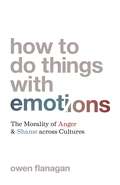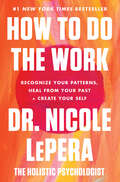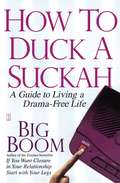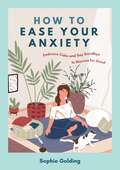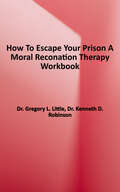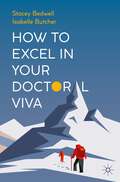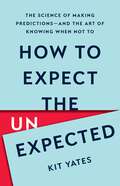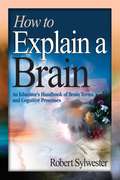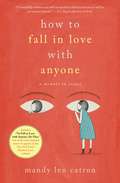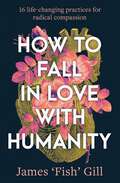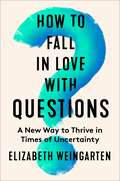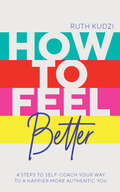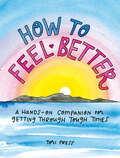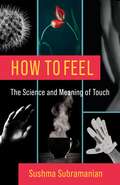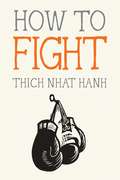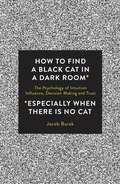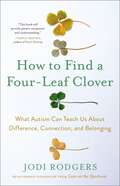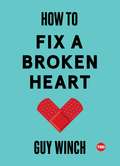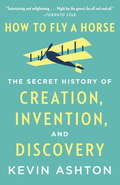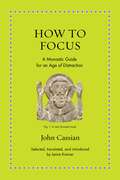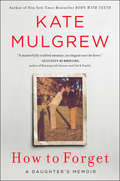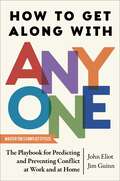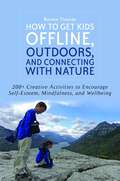- Table View
- List View
How to Do Things with Emotions: The Morality of Anger and Shame across Cultures
by Owen FlanaganAn expansive look at how culture shapes our emotions—and how we can benefit, as individuals and a society, from less anger and more shameThe world today is full of anger. Everywhere we look, we see values clashing and tempers rising, in ways that seem frenzied, aimless, and cruel. At the same time, we witness political leaders and others who lack any sense of shame, even as they display carelessness with the truth and the common good. In How to Do Things with Emotions, Owen Flanagan explains that emotions are things we do, and he reminds us that those like anger and shame involve cultural norms and scripts. The ways we do these emotions offer no guarantee of emotionally or ethically balanced lives—but still we can control and change how such emotions are done. Flanagan makes a passionate case for tuning down anger and tuning up shame, and he observes how cultures around the world can show us how to perform these emotions better.Through comparative insights from anthropology, psychology, and cross-cultural philosophy, Flanagan reveals an incredible range in the expression of anger and shame across societies. He establishes that certain types of anger—such as those that lead to revenge or passing hurt on to others—are more destructive than we imagine. Certain forms of shame, on the other hand, can protect positive values, including courage, kindness, and honesty. Flanagan proposes that we should embrace shame as a uniquely socializing emotion, one that can promote moral progress where undisciplined anger cannot.How to Do Things with Emotions celebrates the plasticity of our emotional responses—and our freedom to recalibrate them in the pursuit of more fulfilling lives.
How to Do the Work: Recognize Your Patterns, Heal from Your Past, and Create Your Self
by Dr. Nicole LePera#1 NEW YORK TIMES BESTSELLER · INSTANT INTERNATIONAL BESTSELLERFrom Dr. Nicole LePera, creator of "the holistic psychologist"—the online phenomenon with more than two million Instagram followers—comes a revolutionary approach to healing that harnesses the power of the self to produce lasting change.As a clinical psychologist, Dr. Nicole LePera often found herself frustrated by the limitations of traditional psychotherapy. Wanting more for her patients—and for herself—she began a journey to develop a united philosophy of mental, physical and spiritual wellness that equips people with the interdisciplinary tools necessary to heal themselves. After experiencing the life-changing results herself, she began to share what she’d learned with others—and soon “The Holistic Psychologist” was born.Now, Dr. LePera is ready to share her much-requested protocol with the world. In How to Do the Work, she offers both a manifesto for SelfHealing as well as an essential guide to creating a more vibrant, authentic, and joyful life. Drawing on the latest research from a diversity of scientific fields and healing modalities, Dr. LePera helps us recognize how adverse experiences and trauma in childhood live with us, resulting in whole body dysfunction—activating harmful stress responses that keep us stuck engaging in patterns of codependency, emotional immaturity, and trauma bonds. Unless addressed, these self-sabotaging behaviors can quickly become cyclical, leaving people feeling unhappy, unfulfilled, and unwell. In How to Do the Work, Dr. LePera offers readers the support and tools that will allow them to break free from destructive behaviors to reclaim and recreate their lives. Nothing short of a paradigm shift, this is a celebration of empowerment that will forever change the way we approach mental wellness and self-care.
How to Duck a Suckah
by Big BoomThe Bodyguard for Women's Hearts returns with brand-new tough-love advice for satisfying relationships and spiritual fulfillment. Some women have become so accustomed to the games and manipulations of men that they are virtually sitting ducks for all the suckahs out there. Every woman has to be able to recognize Mr. Wrong before she lets him into her heart. True love is definitely out there -- you just have to know where to look. In How to Duck a Suckah, Big Boom -- a former pimp, player, and hustler -- draws on his own sordid past to help women avoid traps, demand respect, and live a drama-free life. His overall message of self-empowerment proves that you can't be happy with anyone else unless you are happy with yourself.
How to Ease Your Anxiety: Embrace Calm and Say Goodbye to Worries for Good
by Sophie GoldingCalm your mind, ease your worries and quieten your thoughts with this stunning guide to living an anxiety-free life. Through simple tips and kind advice, this book will show you how to tune out racing thoughts and find mental tranquillity. So dive into these pages and give yourself the gift of a calmer mind.
How to Ease Your Anxiety: Embrace Calm and Say Goodbye to Worries for Good
by Sophie GoldingCalm your mind, ease your worries and quieten your thoughts with this stunning guide to living an anxiety-free life. Through simple tips and kind advice, this book will show you how to tune out racing thoughts and find mental tranquillity. So dive into these pages and give yourself the gift of a calmer mind.
How to Escape Your Prison: A Moral Reconation Therapy Workbook
by Gregory L. Little Kenneth D. RobinsonA Moral Reconation Therapy Workbook. Moral Reconation Therapy is a systematic, cognitive-behavioral, step-by-step treatment strategy designed to enhance self-image, promote growth of a positive, productive identity, and facilitate the development of higher stages of moral reasoning. The term moral reconation was chosen for this system because the underlying goal was to change conscious decision-making to higher levels of moral reasoning.
How to Excel in Your Doctoral Viva
by Stacey Bedwell Isabelle ButcherHow to excel in your doctoral viva offers an accessible guide to approaching and preparing for a PhD viva examination. The book explains what the viva is, how the process works, and what the purpose of the viva is. It guides the reader through the course of preparing for their viva examination, with chapters focusing on organisation to dealing with viva concerns. Contributions from over 25 academics ranging from critical care to theology provide a unique insight into the experiences of PhD candidates and examiners, and make this book an invaluable resource for students completing PhDs across the sciences.
How to Expect the Unexpected: The Science of Making Predictions—and the Art of Knowing When Not To
by Kit YatesA &“vivid, wide-ranging, and delightful guide&” (bestselling author Tim Harford) for understanding how and why predictions go wrong, with practical tips to give you a better chance of getting them right How can you be 100 percent sure you will win a bet? Why did so many Pompeians stay put while Mount Vesuvius was erupting? Are you more likely to work in a kitchen if your last name is Baker? Ever since the dawn of human civilization, we have been trying to make predictions about what the world has in store for us. For just as long, we have been getting it wrong. In How to Expect the Unexpected, mathematician Kit Yates uncovers the surprising science that undergirds our predictions—and how we can use it to our advantage. From religious oracles to weather forecasters, and from politicians to economists, we are subjected to poor predictions all the time. Synthesizing results from math, biology, psychology, sociology, medicine, economic theory, and physics, Yates provides tools for readers to understand uncertainty and to recognize the cognitive biases that make accurate predictions so hard to come by. This book will teach you how and why predictions go wrong, help you to spot phony forecasts, and give you a better chance of getting your own predictions correct.
How to Explain a Brain: An Educator's Handbook of Brain Terms and Cognitive Processes (1-off Ser.)
by Robert SylwesterNoted author Robert Sylwester offers educators and general readers his own definitions for terms used in the cognitive neurosciences. This unique look into the marvelous brain uses language and descriptions that are accessible to readers, even those with just a limited understanding of biology. Discover how our brain is organized and develops, and how educators can use this emerging understanding of cognition to enhance student learning and the school environment. This ready-reference guide to essential concepts and terms in cognitive neurosciences includes: -Nearly three hundred encyclopedic entries and cross references created to help educators understand key concepts about our brain's organization, development, and learning capabilities -Eleven newly created anatomic models and illustrations that focus on key brain systems and functions -References and recommended print and Internet resources How to Explain a Brain celebrates the brain in all its wonder and is sure to become a reference book of choice for teachers, instructional leaders, and teacher educators.
How to Fall in Love with Anyone: A Memoir in Essays
by Mandy Len Catron&“A beautifully written and well-researched cultural criticism as well as an honest memoir&” (Los Angeles Review of Books) from the author of the popular New York Times essay, &“To Fall in Love with Anyone, Do This,&” explores the romantic myths we create and explains how they limit our ability to achieve and sustain intimacy.What really makes love last? Does love ever work the way we say it does in movies and books and Facebook posts? Or does obsessing over those love stories hurt our real-life relationships? When her parents divorced after a twenty-eight year marriage and her own ten-year relationship ended, those were the questions that Mandy Len Catron wanted to answer. In a series of candid, vulnerable, and wise essays that takes a closer look at what it means to love someone, be loved, and how we present our love to the world, &“Catron melds science and emotion beautifully into a thoughtful and thought-provoking meditation&” (Bookpage). She delves back to 1944, when her grandparents met in a coal mining town in Appalachia, to her own dating life as a professor in Vancouver. She uses biologists&’ research into dopamine triggers to ask whether the need to love is an innate human drive. She uses literary theory to show why we prefer certain kinds of love stories. She urges us to question the unwritten scripts we follow in relationships and looks into where those scripts come from. And she tells the story of how she decided to test an experiment that she&’d read about—where the goal was to create intimacy between strangers using a list of thirty-six questions—and ended up in the surreal situation of having millions of people following her brand-new relationship. &“Perfect fodder for the romantic and the cynic in all of us&” (Booklist), How to Fall in Love with Anyone flips the script on love. &“Clear-eyed and full of heart, it is mandatory reading for anyone coping with—or curious about—the challenges of contemporary courtship&” (The Toronto Star).
How to Fall in Love with Humanity: 16 life-changing practices for radical compassion
by James 'Fish' GillOur wellbeing is ultimately founded on fulfilling relationships. Yet how effortlessly misunderstandings, disagreements and conflicts arise with those we care most about! Our political and legal systems promote an adversarial approach to resolution, and pop-psychology labels encourage us to pathologise those who have done us wrong. But the story of victim and villain has only ever deepened opposition. Without skills to mend our inevitable relationship ruptures, upsets prevail and disconnection deepens. No wonder loneliness is recognised globally as the next public health epidemic.By turns fierce and poetic, How to Fall in Love with Humanity delivers what every relationship eventually aches for: a practical roadmap to repair.You'll learn how to lead the way back to love when it goes missing, heal past hurts, mend current relationship upsets and prevent otherwise inevitable future conflicts, while developing your own invincible superpower: how to remain both 'unfuckwithable' and open-hearted in every way.
How to Fall in Love with Humanity: 16 life-changing practices for radical compassion
by James 'Fish' GillOur wellbeing is ultimately founded on fulfilling relationships. Yet how effortlessly misunderstandings, disagreements and conflicts arise with those we care most about! Our political and legal systems promote an adversarial approach to resolution, and pop-psychology labels encourage us to pathologise those who have done us wrong. But the story of victim and villain has only ever deepened opposition. Without skills to mend our inevitable relationship ruptures, upsets prevail and disconnection deepens. No wonder loneliness is recognised globally as the next public health epidemic.By turns fierce and poetic, How to Fall in Love with Humanity delivers what every relationship eventually aches for: a practical roadmap to repair.You'll learn how to lead the way back to love when it goes missing, heal past hurts, mend current relationship upsets and prevent otherwise inevitable future conflicts, while developing your own invincible superpower: how to remain both 'unfuckwithable' and open-hearted in every way.
How to Fall in Love with Questions: A New Way to Thrive in Times of Uncertainty
by Elizabeth WeingartenJournalist and applied behavioral scientist Elizabeth Weingarten charts a new path to embrace the questions of our lives instead of seeking fast, easy answers.What do you do when faced with a big, important question that keeps you up at night? Many people, understandably, seize answers dispensed by “experts,” influencers, gurus, and more. But these fast, easy, one-size-fits-all solutions often fail to satisfy, and can even cause more pain.What if our questions—the ones we ask about relationships, work, meaning, identity, and purpose—are not our tormentors, but our teachers? Inspired by 150-year-old advice from Austrian poet Rainer Maria Rilke and backed by contemporary science, Elizabeth Weingarten offers a fresh approach for dealing with these seemingly unsolvable questions. In her quest, Weingarten shares her own journey and the stories of many others, whose lives have transformed through a different, and better, relationship with uncertainty.Designed to inspire anyone who feels stuck, powerless, and drained, How to Fall in Love with Questions challenges us to unlock our minds and embark on the kind of self-discovery that’s only possible when we feel most alive—that is, when we don’t know what will happen next.
How to Feel Better: 4 Steps to Self-Coach Your Way to a Happier More Authentic You
by Ruth KudziWhen we feel broken we look to be fixed, we consume books, have therapy, diet, whatever it takes! BUT true self development is not about being 'fixed' it's about accepting the parts of yourself and then enhancing who we already are.Focusing on evidence-based approaches, Ruth will teach you how to not just read about, but truly integrate personal development work. She'll take you through 4 key questions that encourage both self-reflection and include action-oriented tasks that will help you create sustainable results.1. What do you want? 2. Where are you now? 3. How do you get to where you want to be? 4. How do you stay there?Ruth started our her personal development journey when studying Psychology as she wanted to know what the f**k was wrong with her: she felt that she was different and wanted to see if there was a scientific reason.Using tools she has developed to help train thousands of coaches, Ruth will help you to create a strong self-coaching mindset, helping you to rewire your brain, so that you can adopt new ways of thinking, feeling and behaving. She draws from a variety of disciplines including neuroscience, positive psychology, somatic and energy work to provide a truly unique self-coaching programme that is totally results focused.
How to Feel Better: A Hands-On Companion for Getting Through Tough Times
by Tori PressAn illustrated guide to the life-changing practice of emotional self-care, by the popular Instagram artist @revelatori.We can&’t control life&’s ups and downs—but we can try to make our path a little smoother. In this honest and encouraging guide, popular Instagram artist Tori Press shares daily practices, wry and vulnerable observations, and plenty of ideas to explore on the road to emotional wellness, including reconnecting with nature, simple mindfulness exercises, and a beginner&’s guide to the mind-expanding experience of talk therapy. Whether you&’re coping with anxiety, depression, grief, or simply the uncertainties of life in our chaotic and always-on world, this colorful, practical companion offers validation, support, and encouragement along your journey to a calmer, happier tomorrow.
How to Feel: The Science and Meaning of Touch
by Sushma SubramanianWe are out of touch. Many people fear that we are trapped inside our screens, becoming less in tune with our bodies and losing our connection to the physical world. But the sense of touch has been undervalued since long before the days of digital isolation. Because of deeply rooted beliefs that favor the cerebral over the corporeal, touch is maligned as dirty or sentimental, in contrast with supposedly more elevated modes of perceiving the world.How to Feel explores the scientific, physical, emotional, and cultural aspects of touch, reconnecting us to what is arguably our most important sense. Sushma Subramanian introduces readers to the scientists whose groundbreaking research is underscoring the role of touch in our lives. Through vivid individual stories—a man who lost his sense of touch in his late teens, a woman who experiences touch-emotion synesthesia, her own efforts to become less touch averse—Subramanian explains the science of the somatosensory system and our philosophical beliefs about it. She visits labs that are shaping the textures of objects we use every day, from cereal to synthetic fabrics. The book highlights the growing field of haptics, which is trying to incorporate tactile interactions into devices such as phones that touch us back and prosthetic limbs that can feel. How to Feel offers a new appreciation for a vital but misunderstood sense and how we can use it to live more fully.
How to Fight (Mindfulness Essentials #6)
by Thich Nhat Hanh Jason DeantonisLearn how to relax the bonds of anger, attachment, and delusion through mindfulness and kindness toward ourselves and others.The Mindfulness Essentials series introduces beginners and reminds seasoned practitioners of the essentials of mindfulness practice. This time Nhat Hanh brings his signature clarity, compassion, and humor to the ways we act out in anger, frustration, despair, and delusion. In brief meditations accompanied by whimsical sumi-ink drawings, Thich Nhat Hanh instructs us exactly how to transform our craving and confusion. If we learn to take good care of our suffering, we can help others do the same. How to Fight is pocket-sized with two color original artwork by California artist Jason DeAntonis.
How to Find a Black Cat in a Dark Room: The Psychology of Intuition, Influence, Decision Making and Trust
by Jacob BurakAn inquiry into what it is about our experiences and cultures that brings out the differences and reveals the similarities in us as humans beings, in the vein of Malcolm Gladwell and Daniel Kahneman.Jacob Burak is on a quest to answer the question “are we as human beings, who are separated by different cultures and experiences, similar or different?” Through the lens of behavioural studies, we see how, while our approaches differ and often conflict, we all strive for similar things: love, acceptance, power and understanding. How to Find a Black Cat in a Dark Room offers the latest scientific studies of human behaviour alongside accessible anecdotes to examine the universal human experiences of comparing ourselves to others, the need to belong, the urge to achieve and the anxiety and uncertainty of life itself.More importantly, Burak shows us how, in understanding these behavioural patterns, we learn that we are actually more alike than we are different; that our rivals often make us stronger; and that being trusting can help us live longer. With his inquisitive nature, logical thinking and engaging style, Burak examines whether it is destiny or personality that controls our lives, through intriguing subjects such as: • What are the ten rules for happiness that are entirely under our control? • Why do smart people make stupid mistakes? • What distinguishes bureaucrats and entrepreneurs? • What are the psychological differences between liberals and conservatives? • In what circumstances is it right to surrender our privacy? • Does it pay to trust people?
How to Find a Four-Leaf Clover: What Autism Can Teach Us About Difference, Connection, and Belonging
by Jodi RodgersA powerfully moving read from beloved Love on the Spectrum star and disability rights advocate Jodi Rodgers, sharing lessons from her work within the autistic community that can help create a more inclusive society for us all. In How to Find a Four-Leaf Clover, Jodi Rodgers gives us inspiring, heartwarming stories from her years of experience as a teacher and counselor supporting autistic people. While acknowledging our differences, these stories invite us to expand our empathy and compassion for the neurodivergent people in our lives. Throughout, Rodgers explores the powerful impact of embracing neurodiversity and forming meaningful connections with those around us. Each chapter highlights a different story and an aspect of human behavior, including: How we perceive the world, and our own unique experience of thinking, sensing, and feeling How we communicate our perspective to others, understand one another, and express ourselves How we can better connect with one another With dozens of moving stories, How to Find a Four-Leaf Clover will give readers a deeper understanding of and appreciation for the neurodiverse community around them. Above all, it will inspire a profound sense of belonging, revealing that we&’re much more similar than we think.
How to Fix a Broken Heart (TED Books)
by Dr Guy WinchImagine if we treated broken hearts with the same respect and concern we have for broken arms? Psychologist Guy Winch urges us to rethink the way we deal with emotional pain, offering warm, wise, and witty advice for the broken-hearted.Real heartbreak is unmistakable. We think of nothing else. We feel nothing else. We care about nothing else. Yet while we wouldn&’t expect someone to return to daily activities immediately after suffering a broken limb, heartbroken people are expected to function normally in their lives, despite the emotional pain they feel. Now psychologist Guy Winch imagines how different things would be if we paid more attention to this unique emotion—if only we can understand how heartbreak works, we can begin to fix it. Through compelling research and new scientific studies, Winch reveals how and why heartbreak impacts our brain and our behavior in dramatic and unexpected ways, regardless of our age. Emotional pain lowers our ability to reason, to think creatively, to problem solve, and to function at our best. In How to Fix a Broken Heart he focuses on two types of emotional pain—romantic heartbreak and the heartbreak that results from the loss of a cherished pet. These experiences are both accompanied by severe grief responses, yet they are not deemed as important as, for example, a formal divorce or the loss of a close relative. As a result, we are often deprived of the recognition, support, and compassion afforded to those whose heartbreak is considered more significant. Our heart might be broken, but we do not have to break with it. Winch reveals that recovering from heartbreak always starts with a decision, a determination to move on when our mind is fighting to keep us stuck. We can take control of our lives and our minds and put ourselves on the path to healing. Winch offers a toolkit on how to handle and cope with a broken heart and how to, eventually, move on.
How to Fly a Horse: The Secret History of Creation, Invention, and Discovery
by Kevin AshtonAs a technology pioneer at MIT and as the leader of three successful start-ups, Kevin Ashton experienced firsthand the all-consuming challenge of creating something new. Now, in a tour-de-force narrative twenty years in the making, Ashton leads us on a journey through humanity's greatest creations to uncover the surprising truth behind who creates and how they do it. From the crystallographer's laboratory where the secrets of DNA were first revealed by a long forgotten woman, to the electromagnetic chamber where the stealth bomber was born on a twenty-five-cent bet, to the Ohio bicycle shop where the Wright brothers set out to "fly a horse," Ashton showcases the seemingly unremarkable individuals, gradual steps, multiple failures, and countless ordinary and usually uncredited acts that lead to our most astounding breakthroughs.Creators, he shows, apply in particular ways the everyday, ordinary thinking of which we are all capable, taking thousands of small steps and working in an endless loop of problem and solution. He examines why innovators meet resistance and how they overcome it, why most organizations stifle creative people, and how the most creative organizations work. Drawing on examples from art, science, business, and invention, from Mozart to the Muppets, Archimedes to Apple, Kandinsky to a can of Coke, How to Fly a Horse is a passionate and immensely rewarding exploration of how "new" comes to be.
How to Focus: A Monastic Guide for an Age of Distraction (Ancient Wisdom for Modern Readers)
by John CassianHow you can learn to focus like a monk without living like oneDistraction isn’t a new problem. We’re also not the first to complain about how hard it is to concentrate. Early Christian monks beat us to it. They had given up everything to focus on God, yet they still struggled to keep the demons of distraction at bay. But rather than surrender to the meandering of their minds, they developed powerful strategies to improve their attention and engagement. How to Focus is an inviting collection of their strikingly relatable insights and advice—frank, funny, sympathetic, and psychologically sophisticated.This wisdom is drawn from John Cassian’s fifth-century CE Collationes, one of the most influential manuals for monks from late antiquity. The Collationes follow Cassian and his friend Germanus as they travel around Egypt, asking a series of sage monks how they can make their minds stronger. In response, these monks offer a range of techniques for increasing focus, including setting goals, training the body, managing the memory, using mantras, taking breaks, consulting others—and, most of all, being honest about yourself. As Cassian and Germanus eventually realize, we can’t escape distraction—but we can learn how to confront it and, eventually, to concentrate.Featuring an engaging new translation by Jamie Kreiner and the original Latin on facing pages, How to Focus can help even the least monkish of us to train our attention on what matters most.
How to Forget: A Daughter’s Memoir
by Kate MulgrewIn this profoundly honest and examined memoir about returning to Iowa to care for her ailing parents, the star of Orange Is the New Black and bestselling author of Born with Teeth takes us on an unexpected journey of loss, betrayal, and the transcendent nature of a daughter’s love for her parents. They say you can’t go home again. But when her father is diagnosed with aggressive lung cancer and her mother with atypical Alzheimer’s, New York-based actress Kate Mulgrew returns to her hometown in Iowa to spend time with her parents and care for them in the time they have left.The months Kate spends with her parents in Dubuque—by turns turbulent, tragic, and joyful—lead her to reflect on each of their lives and how they shaped her own. Those ruminations are transformed when, in the wake of their deaths, Kate uncovers long-kept secrets that challenge her understanding of the unconventional Irish Catholic household in which she was raised.Breathtaking and powerful, laced with the author’s irreverent wit, How to Forget is a considered portrait of a mother and a father, an emotionally powerful memoir that demonstrates how love fuses children and parents, and an honest examination of family, memory, and indelible loss.
How to Get Along with Anyone: The Playbook for Predicting and Preventing Conflict at Work and at Home
by John Eliot Jim GuinnDefuse any heated conflict by learning which of the five conflict styles you are and how to resolve even the most sensitive dispute with this must-read guide.The average American worker spends 156 hours a year engaged in the kind of moderate to intense workplace conflict that adversely impacts both performance and health. Managers spend twenty-six percent of their time addressing and resolving conflicts on their team—the equivalent of chewing up one full workday each week. But what if it didn&’t need to be like this? What if there was a way to spend less time in stressfully interpersonal interactions and more time on the things that really matter? Through three decades of building and facilitating team chemistry for Fortune 500 companies, professional sports franchises, schools, government agencies, nonprofit organizations, and families—Drs. Jim Guinn and John Eliot have reduced the time and cost of conflict resolution. With this on-the-ground experience combined with industry-leading science and research, Guinn and Eliot discovered people respond to conflict in one of five ways: avoid, compete, analyze, collaborate, or accommodate. Because our responses are ingrained byproducts of the subcortex in action, they are predictable. If you can predict how someone will behave in a given circumstance, you can formulate a game plan. The secret is knowing which of the five patterns someone is wired to use when smacked by a stressor. How to Get Along with Anyone is a pragmatic hands-on book to help you determine conflict types so you can navigate the arguments that emerge in day-to-day life. You&’ll learn the formula for identifying your coworkers&’ and loved ones&’ conflict styles and how to use this information to foster better communication and more effective, collaboration. Filled with fun, engaging examples and actionable techniques, How to Get Along with Anyone teaches you how to predict and prevent escalated conflict, arming you with practical tools for flipping the script on sticking points to nurture stronger and more meaningful relationships.
How to Get Kids Offline, Outdoors, and Connecting with Nature: 200+ Creative activities to encourage self-esteem, mindfulness, and wellbeing
by Bonnie ThomasFull of ideas, activities and exercises, this book provides imaginative ways to inspire young people to put down the computer games, disconnect from social media, and spend more time away from a screen. In an increasingly electronic world, creating enthusiasm for the great outdoors can seem an impossible task. Yet, the benefits of nature are endless, and they extend further than just improving physical health; being in natural surroundings is also an effective way to boost imagination, creativity and overall wellbeing. In whatever capacity you work or care for children and young people, this book will help you motivate them to reboot their connection with nature and become healthier for it. Addressing how nature-based activities can be used for improved mental health, this book will be an invaluable addition to the library of any professional who works with young people including counselors, educators, youth group workers, social workers, and childcare providers. It is also a useful resource for parents.
